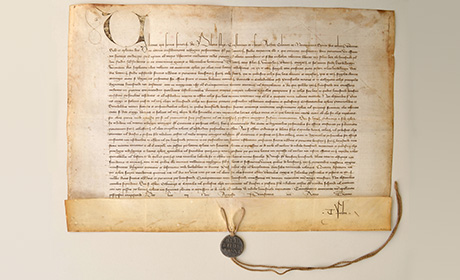Document from the Early Years of the University Returns to Heidelberg
7 August 2014

Photo: Universitätsarchiv Heidelberg
A papal bull from the early years of Heidelberg University hitherto believed lost has now found its way back home. It disappeared from the University Archives in the post-Second World War period and was recently discovered by chance in a house in St Louis, USA. By diplomatic courier and special transport the mediaeval document was brought back to Heidelberg. After first being entrusted to the restoration workshops of the State Archives in Ludwigsburg it has now been returned to Heidelberg University Archives. The papal bull was issued by Pope Urban VI and dates from 1387. In the course of a presentation for the press it has now been shown to the public for the first time.
“The document is completely original, including the hempen cord attached to the papal seal,” says Dr. Ingo Runde, director of Heidelberg University Archives. Although it was kept for decades in surroundings hardly appropriate for the storage of such a document, the papal bull arrived in Germany in relatively good condition, says Dr. Anna Haberditzl, deputy head of the Institute for the Preservation of Archival and Library Holdings at the State Archives of Baden-Württemberg. For restoration purposes the experts had to extricate the document from the adhesive attaching it to a former picture frame. It then had to be completely “flattened” to take the tension out of the parchment. The papal bull was cleansed and subsequently dried for a lengthy period of time. The rent in the centre of the document, probably caused by storage in the frame referred to earlier, was then successfully closed, Dr. Haberditzl reports.
It remains unclear how the document got from Heidelberg to the USA in the chaos immediately after the Second World War, says Dr. Runde. During a verification of the holdings of the Archives in December 1947/January 1948, eight medieval documents were found missing. Alongside the newly rediscovered papal bull, the other items that disappeared in that period were two papal documents and five documents issued by the county palatine in the early years of the University. They date from 1386 to 1389. Only one of these documents (alongside the papal bull) has been restored to the University so far, the very first founding document signed by county palatine Ruprecht I in 1386. For safekeeping during the Second World War, this document was removed from the archives earlier than the other holdings. It was returned in the course of the year 1945, although it was not incorporated into the University Archives until 1955. Now the return of the papal bull nurtures hopes that “due to the interest in the media the chance find will perhaps bring clues to light about the whereabouts of the other documents on the ‘missing, believed lost’ list,” says Dr. Runde. “The dates of issue are so close that it seems likely that the documents were kept in the same place and thus may indeed have found their way across the Atlantic together as well.”
The papal bull was discovered in the attic of a private house in St Louis. The finders contacted Heidelberg University Archives via the internet. With the help of the Institute for the Preservation of Archival and Library Holdings under its then director Frieder Kuhn, the Archives arranged for the mediaeval document to be entrusted to the German consul-general in Chicago, Dr. Christian Brecht. He received it in person from the sister of the finder, who had discovered it in the attic among her mother’s possessions. She was surprised to come across a document in Latin in her mother’s house. Curious about its origins, she approached the Institute of Jesuit Sources in St Louis, which identified Heidelberg University as the home of the bull. How the document ended up amongst the possessions of their mother is a complete mystery to the two sisters. From the Consulate-General in Chicago the document was first sent to the Political Archives of the Federal Ministry of Foreign Affairs in Berlin, which had provided assistance in getting the papal bull back safely from overseas, and from there to Heidelberg.
The rediscovered document is dated August 1387. In it, Pope Urban VI confers on the clergy associated with Heidelberg University the privilege of absenting themselves from their prebendary lands for a period of five years. According to Dr. Runde the papal bull is a highly valuable historical document. The University Archives hold another 23 papal documents from the period between 1234 and 1816. At a later date, the most important of these will be shown to the public in the framework of a special exhibition.

